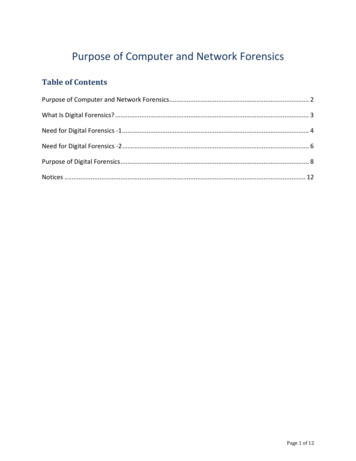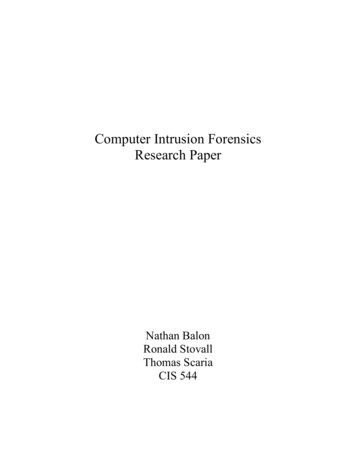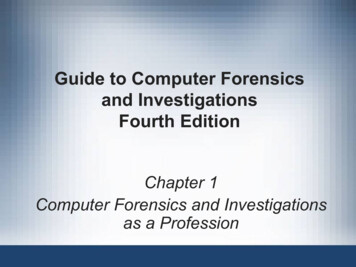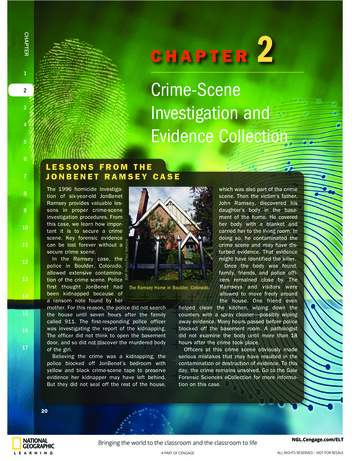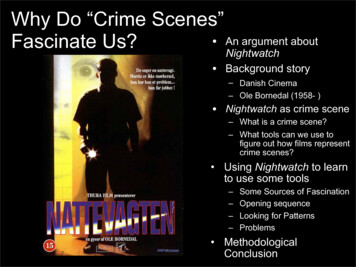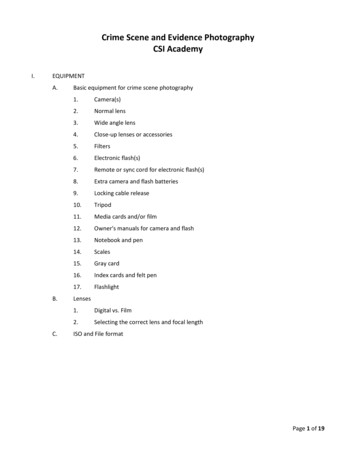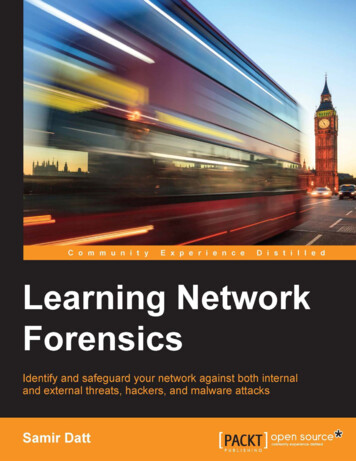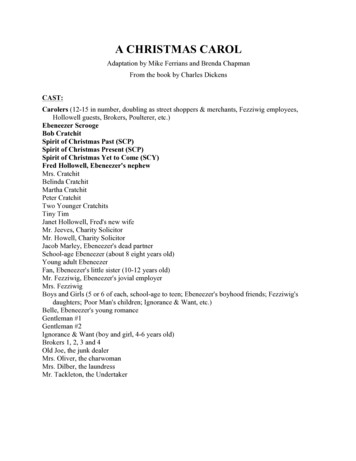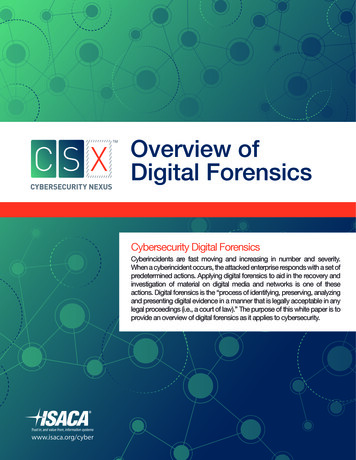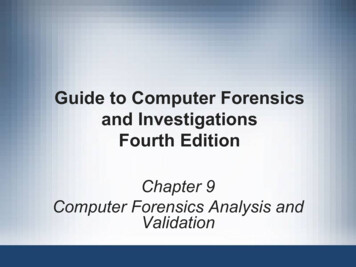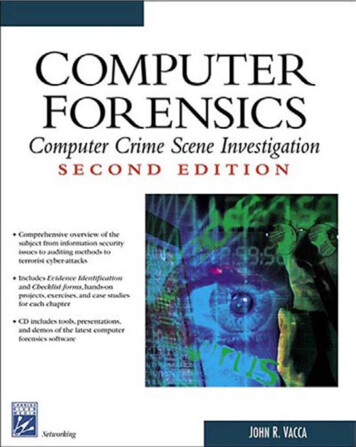
Transcription
Computer ForensicsSecond Edition
LIMITED WARRANTY AND DISCLAIMER OF LIABILITYTHE CD-ROM THAT ACCOMPANIES THE BOOK MAY BE USED ON A SINGLE PCONLY. THE LICENSE DOES NOT PERMIT THE USE ON A NETWORK (OF ANYKIND). YOU FURTHER AGREE THAT THIS LICENSE GRANTS PERMISSION TO USETHE PRODUCTS CONTAINED HEREIN, BUT DOES NOT GIVE YOU RIGHT OFOWNERSHIP TO ANY OF THE CONTENT OR PRODUCT CONTAINED ON THIS CDROM. USE OF THIRD-PARTY SOFTWARE CONTAINED ON THIS CD-ROM IS LIMITED TO AND SUBJECT TO LICENSING TERMS FOR THE RESPECTIVE PRODUCTS.CHARLES RIVER MEDIA, INC. (“CRM”) AND/OR ANYONE WHO HAS BEEN INVOLVED IN THE WRITING, CREATION, OR PRODUCTION OF THE ACCOMPANYING CODE (“THE SOFTWARE”) OR THE THIRD-PARTY PRODUCTS CONTAINEDON THE CD-ROM OR TEXTUAL MATERIAL IN THE BOOK, CANNOT AND DO NOTWARRANT THE PERFORMANCE OR RESULTS THAT MAY BE OBTAINED BY USINGTHE SOFTWARE OR CONTENTS OF THE BOOK. THE AUTHOR AND PUBLISHERHAVE USED THEIR BEST EFFORTS TO ENSURE THE ACCURACY AND FUNCTIONALITY OF THE TEXTUAL MATERIAL AND PROGRAMS CONTAINED HEREIN. WEHOWEVER, MAKE NO WARRANTY OF ANY KIND, EXPRESS OR IMPLIED, REGARDING THE PERFORMANCE OF THESE PROGRAMS OR CONTENTS. THE SOFTWAREIS SOLD “AS IS” WITHOUT WARRANTY (EXCEPT FOR DEFECTIVE MATERIALS USEDIN MANUFACTURING THE DISK OR DUE TO FAULTY WORKMANSHIP).THE AUTHOR, THE PUBLISHER, DEVELOPERS OF THIRD-PARTY SOFTWARE,AND ANYONE INVOLVED IN THE PRODUCTION AND MANUFACTURING OFTHIS WORK SHALL NOT BE LIABLE FOR DAMAGES OF ANY KIND ARISING OUTOF THE USE OF (OR THE INABILITY TO USE) THE PROGRAMS, SOURCE CODE, ORTEXTUAL MATERIAL CONTAINED IN THIS PUBLICATION. THIS INCLUDES, BUTIS NOT LIMITED TO, LOSS OF REVENUE OR PROFIT, OR OTHER INCIDENTAL ORCONSEQUENTIAL DAMAGES ARISING OUT OF THE USE OF THE PRODUCT.THE SOLE REMEDY IN THE EVENT OF A CLAIM OF ANY KIND IS EXPRESSLY LIMITED TO REPLACEMENT OF THE BOOK AND/OR CD-ROM, AND ONLY AT THEDISCRETION OF CRM.THE USE OF “IMPLIED WARRANTY” AND CERTAIN “EXCLUSIONS” VARIES FROMSTATE TO STATE, AND MAY NOT APPLY TO THE PURCHASER OF THIS PRODUCT.
Computer Forensics:Computer CrimeScene InvestigationSecond EditionJohn R. VaccaCHARLES RIVER MEDIA, INC.Boston, Massachusetts
Copyright 2005 Career & Professional Group, a division of Thomson Learning, Inc.Published by Charles River Media, an imprint of Thomson Learning Inc.All rights reserved.No part of this publication may be reproduced in any way, stored in a retrieval system of anytype, or transmitted by any means or media, electronic or mechanical, including, but notlimited to, photocopy, recording, or scanning, without prior permission in writing from thepublisher.Cover Design: Tyler CreativeCHARLES RIVER MEDIA25 Thomson PlaceBoston, Massachusetts 02210617-757-7900617-757-7969 (FAX)crm.info@thomson.comwww.charlesriver.comThis book is printed on acid-free paper.John R. Vacca. Computer Forensics: Computer Crime Scene Investigation, Second Edition.ISBN: 1-58450-389-0ISBN-13: 978-1-58450-389-7eISBN: 1-58450-637-7All brand names and product names mentioned in this book are trademarks or service marksof their respective companies. Any omission or misuse (of any kind) of service marks or trademarks should not be regarded as intent to infringe on the property of others. The publisherrecognizes and respects all marks used by companies, manufacturers, and developers as ameans to distinguish their products.Library of Congress Cataloging-in-Publication DataVacca, John R.Computer forensics : computer crime scene investigation / John R. Vacca.-- 2nd ed.p. cm.Includes bibliographical references and index.ISBN 1-58450-389-0 (pbk. with cd-rom : alk. paper)1. Computer security. 2. Computer networks--Security measures. 3. Forensic sciences. I. Title.QA76.9.A25V33 2005005.8--dc222005007521Printed in the United States of America07 7 6 5 4 3CHARLES RIVER MEDIA titles are available for site license or bulk purchase by institutions, usergroups, corporations, etc. For additional information, please contact the Special Sales Department at 800-347-7707.Requests for replacement of a defective CD-ROM must be accompanied by the original disc,your mailing address, telephone number, date of purchase and purchase price. Please state thenature of the problem, and send the information to CHARLES RIVER MEDIA, 25 Thomson Place,Boston, Massachusetts 02210. CRM’s sole obligation to the purchaser is to replace the disc,based on defective materials or faulty workmanship, but not on the operation or functionalityof the product.
In memory of Giacchi and Agrippina.
This page intentionally left blank
ContentsAcknowledgmentsForewordIntroductionPart I Overview of Computer Forensics Technology1xixxxixxv1Computer Forensics Fundamentals3Introduction to Computer Forensics4Use of Computer Forensics in Law Enforcement8Computer Forensics Assistance to Human Resources/Employment Proceedings9Computer Forensics Services10Benefits of Professional Forensics Methodology17Steps Taken by Computer Forensics Specialists18Who Can Use Computer Forensic Evidence?18Case Histories24Case Studies27Summary28Chapter Review Questions and Exercises31Hands-On Projects33References34vii
viiiComputer Forensics, Second Edition23Types of Computer Forensics Technology35Types of Military Computer Forensic Technology36Types of Law Enforcement: Computer Forensic Technology38Types of Business Computer Forensic Technology52Specialized Forensics Techniques57Hidden Data and How to Find It61Spyware and Adware61Encryption Methods and Vulnerabilities63Protecting Data from Being Compromised64Internet Tracing Methods65Security and Wireless Technologies69Avoiding Pitfalls with Firewalls71Biometric Security Systems72Summary73Chapter Review Questions and Exercises77Hands-On Projects79References81Types of Computer Forensics Systems83Internet Security Systems84Intrusion Detection Systems91Firewall Security Systems99Storage Area Network Security Systems108Network Disaster Recovery Systems112Public Key Infrastructure Systems113Wireless Network Security Systems115Satellite Encryption Security Systems118Instant Messaging (IM) Security Systems125Net Privacy Systems126Identity Management Security Systems129Identity Theft137
Contents4Biometric Security Systems141Homeland Security Systems143Summary145Chapter Review Questions and Exercises148Hands-on Projects150References151Vendor and Computer Forensics Services153Occurrence of Cyber Crime154Cyber Detectives155Fighting Cyber Crime with Risk-Management Techniques156Computer Forensics Investigative Services162Forensic Process Improvement167Course Content176Case Histories180Summary182Chapter Review Questions and Exercises184Hands-On Projects186References186Part II Computer Forensics Evidence and Capture5ixData Recovery189191Data Recovery Defined191Data Backup and Recovery192The Role of Backup in Data Recovery200The Data-Recovery Solution203Hiding and Recovering Hidden Data206Case Histories209Summary212Chapter Review Questions and Exercises214Hands-On Projects216References216
xComputer Forensics, Second Edition678Evidence Collection and Data Seizure217Why Collect Evidence?217Collection Options218Obstacles218Types of Evidence219The Rules of Evidence220Volatile Evidence223General Procedure224Collection and Archiving224Methods of Collection225Artifacts226Collection Steps226Controlling Contamination: The Chain of Custody228Reconstructing the Attack229Summary229Chapter Review Questions and Exercises231Hands-on Projects232References233Duplication and Preservation of Digital Evidence235Preserving the Digital Crime Scene238Computer Evidence Processing Steps240Legal Aspects of Collecting and Preserving Computer Forensic Evidence247Summary252Chapter Review Questions and Exercises254Hands-on Projects255References256Computer Image Verification and Authentication257Special Needs of Evidential Authentication258Practical Considerations264
ContentsPractical Implementation265Summary268Chapter Review Questions and Exercises271Hands-on Projects273References273Part III Computer Forensics Analysis91011xiDiscovery of Electronic Evidence275277Electronic Document Discovery: A Powerful New Litigation Tool278Summary281Chapter Review Questions and Exercises283Hands-on Projects285References285Identification of Data287Timekeeping288Forensic Identification and Analysis of Technical Surveillance Devices291Summary297Chapter Review Questions and Exercises299Hands-on Projects300References301Reconstructing Past Events303How to Become a Digital Detective304Useable File Formats305Unusable File Formats305Converting Files306Summary309Chapter Review Questions and Exercises310Hands-on Projects312References313
xii12Computer Forensics, Second EditionNetworksNetwork Forensics Scenario316A Technical Approach316Destruction of Email319Damaging Computer Evidence321Tools Needed for Intrusion Response to the Destruction of Data323System Testing324Summary326Chapter Review Questions and Exercises328Hands-on Projects330References331Part IV Countermeasures: Information Warfare1314315Fighting Against Macro Threats: Defensive Strategiesfor Governments and Industry Groups333335Is the U.S. Government Prepared for Information Warfare?335Are Other Governments Prepared for Information Warfare?339What Industry Groups Have Done to Prepare for Information Warfare341Strategic Diplomacy and Information Warfare344The Role of International Organizations354The Role of Global Military Alliances359Marshall Law and Cyberspace361The Super Cyber Protection Agencies363Summary365Chapter Review Questions and Exercises367Hands-on Projects370References370The Information Warfare Arsenal and Tactics of the Military371Overview of Military Tactics376Offensive Ruinous IW Tools and Tactics378Offensive Containment IW Tools and Tactics380
Contents1516xiiiDefensive Preventive IW Tools and Tactics384Defensive Ruinous IW Tools and Tactics385Defensive Responsive Containment IW Tools and Tactics386Countering Sustained Terrorist IW Tactics389Dealing with Random Terrorist IW394Summary407Chapter Review Questions and Exercises410Hands-on Projects412References413The Information Warfare Arsenal and Tactics of Terroristsand Rogues415The Terrorist Profile421Why Terrorists and Rogues Have an Advantage in IW424The Dark World of the Cyber Underground430The Criminal Café in Cyberspace433The Super Computer Literate Terrorist438The New Security Professionals440The Middle East Cyberwar441The New Tools of Terrorism444Why Tools Are Easy to Get and Use452Why Nasty People Are So Hard to Track Down and Capture453The IW Games459Summary462Chapter Review Questions and Exercises465Hands-on Projects467References468The Information Warfare Arsenal and Tactics of Private Companies469Surviving Offensive Ruinous IW476Surviving Offensive Containment IW478Participating in Defensive Preventive IW Planning480
xiv1718Computer Forensics, Second EditionBenefiting from and Surviving Defensive Ruinous IW482Benefiting from and Surviving Defensive Responsive Containment IW484Protection Against Random Terrorist IW Tactics487What to Do When Terrorists Keep Attacking490Countering Sustained Rogue IW492Protection Against Random Rogue IW493Keeping the Amateur Rogue out of the Cyberhouse501Summary501Chapter Review Questions and Exercises503Hands-on Projects505References506The Information Warfare Arsenal of the Future507Weapons of the Future509The Global Positioning System522Snoop, Sniff, and Snuff Tools527Email Wiretaps Like Carnivore Can Steal Sensitive Correspondence529IW Weapons of the Future532Nanotechnology538Summary543Chapter Review Questions and Exercises545Hands-on Projects547References547Surveillance Tools for Information Warfare of the Future549Monitoring Everything549Cyber Surveillance552The Cyber Footprint and Criminal Tracking553The Implications of Cookies and Integrated Platforms564Wintel Inside, or How Your Computer Is Watching You566Data Mining for What?569The Internet Is Big Brother577
Contents19The Wireless Internet: Friend or Foe?579Summary580Chapter Review Questions and Exercises582Hands-on Projects583References584Civilian Casualties: The Victims and Refugees ofInformation Warfare585What the Cyber Masses Have to Lose587The Destruction of Personal Assets in IWs597Short- and Long-Term Personal Economic Impact on Cyber Citizens601The Violation of Privacy During Information Wars602The Individual Exposed604Identity Theft606Monitoring Private Affairs in Cyberspace609The New Order and State Medical ID Cards613Big Brother Is Here and Is Staying616Summary618Chapter Review Questions and Exercises620Hands-on Projects622References623Part V Advanced Computer Forensics Systems and Future Directions20xvAdvanced Computer Forensics625627Advanced Encryption: The Need to Conceal628Advanced Hacking640Advanced Tracker Hackers647The Problems of the Present663Summary666Chapter Review Questions and Exercises669Hands-on Projects670References671
xvi21Computer Forensics, Second EditionSummary, Conclusions, and dations684Final Word: Computer Forensic Needs and Challenges699Chapter Review Questions and Exercises700References703Appendix A Frequently Asked Questions705What Is Computer Forensics?705Why Computer Forensics?705What Is Data Recovery?705Are There Instances When Data Cannot Be Recovered?706Appendix B Computer Forensics Resources709General Forensics Resources709Computer Crime711File Formats and Extensions711Cryptography and Steganography712Appendix C Links to Computer Forensics and Related LawEnforcement Web Pages713Law Enforcement Links713Organizations714Mailing Lists714USDOJ Guidelines for Searching and Seizing Computers715Computer Forensic and Security Software Available Free ofCharge to Law Enforcement Agencies715Miscellaneous715
ContentsAppendix D More Computer Forensics Casesxvii717Case Study 1: Lost Files717Case Study 2: Corrupted Files718Case Study 3: Disappearing Files718Case Study 4: Computer Forensics718Case Study 5: Forensic Accounting719Case Study 6: Corporate Investigation into PC Pornography719Case Study 7: Data Recovery719Case Study 8: Industrial Espionage720Case Study 9: Family Members Bolt720Case Study 10: Former Employer720Case Study 11: Goods Left to Rot721Case Study 12: Managers Start New Company721Case Study 13: Family Member Steals Clients721Case Study 14: Erased Email721Case Study 15: Bank Suspects722Case Study 16: Former Managers722Case Study 17: Former Catalog Designers722Case Study 18: Model Pursued722Case Study 19: Encrypted Mail723Case Study 20: Two Attorneys Can’t Speak Civilly723Case Study 21: Big Real Estate Deal723Case Study 22: Doctor Accused723Case Study 23: Former Employee Claims724Case Study 24: Ex-Partner Claims724Case Study 25: Former Manager724
xviiiComputer Forensics, Second EditionAppendix E Answers to Review Questions and Exercises,Hands-on Projects, Case Projects, andOptional Team Case Projects by Chapter725Appendix F Checklists by Chapter747Appendix G About the CD-ROM781Appendix H Glossary of Terms and Acronyms791Index819
Acknowledgmentshere are many people whose efforts on this book have contributed to itssuccessful completion. I owe each a debt of gratitude and want to take thisopportunity to offer my sincere thanks.A very special thanks to my publisher, David Pallai, without whose initialinterest and support this book would not have been possible, for his guidance andencouragement over and above the business of being a publisher. Thanks also toBryan Davidson, Ania Wieckowski, and Jennifer Blaney of Charles River Media,whose many talents and skills are essential to a finished book. Thanks to my copyeditor, Ruth Saavedra, whose fine editorial work has been invaluable. Thanks alsoto my marketing manager, Meg Dunkerley, whose efforts on this book have beengreatly appreciated. Finally, a special thanks to Michael Erbschloe, who wrote theForeword for this book.Thanks to my wife, Bee Vacca, for her love, her help, and her understanding ofmy long work hours.Finally, I wish to thank the organizations and individuals who granted me permission to use the research material and information necessary for the completionof this book.Txix
This page intentionally left blank
Forewordomputer crime and computer-supported criminal activities are boomingbusinesses. Criminals, fraudsters, and terrorists seem to strike wheneverthere is an opportunity. In January of 2005 the FBI alerted the public to avariety of scams being facilitated online involving the solicitation of additional relief funds for the victims of the recent tsunami disaster. The FBI, through the Internet Crime Complaint Center (IC3), had received reports of Web sites beingestablished purportedly to assist with collection and relief efforts. Complaints identified several schemes that involved both unsolicited incoming emails (SPAM), aswell as reports of responses to posted email addresses, to assist for a fee in locatingloved ones who may have been victims of the disaster. A fraudulent relief donationWeb site has also been detected containing an embedded Trojan exploit which caninfect the user’s computer with a virus if accessed.There have been several major inter-agency computer crime investigationsconducted during the last several years including WEB-SNARE, which, on August26, 2004, was characterized by the Attorney General as the most successful cybercrime initiative to date. In WEB-SNARE, more than 150 investigations were successfully advanced, in which more than 150,000 victims lost more than 215 million. This initiative included 150 subjects who were charged, and the execution of170 search and/or seizure warrants. Many of the investigations included in WEBSNARE could potentially be characterized as Identity Theft, or related to IdentityTheft.Prior to WEB-SNARE, the IC3 coordinated the development and execution ofOperations E-Con and Cyber Sweep with our law enforcement and industry partners. In those initiatives, more than 200 investigations were coordinated among thevarious law enforcement agencies, resulting in arrests and/or charges of more than250 individuals for engaging in a variety of cyber crimes including Identity Theft.The FBI has also observed a continuing increase in both volume and potentialimpact of cyber crime with significant international elements. Identifying suchCxxi
xxiiComputer Forensics, Second Editiontrends, as well as formulating an aggressive and proactive counter-attack strategy,remains a fundamental objective of the FBI’s Cyber Division. In a growing numberof cases, Eastern European subjects solicit victims though job postings, email solicitations, and chat-rooms to provide detailed personal information. Once that information is obtained, they use their identities to post auctions on well-knownauction sites. Funds obtained through the auction are transferred through severalshell accounts, both in the U.S and abroad, and the items sold are never delivered.In one FBI investigation initiated in 1999, the computer network of a now defunct software e-commerce company was compromised, and credit card information for approximately eight million accounts was obtained by the hackers. Thecompromised e-commerce company was contacted via email by the hackers whodemanded money to keep them from publicly posting the obtained information onthe Internet. The FBI became aware of this crime when numerous field offices received complaints from citizens who were all incorrectly charged for similar smallamounts on their credit card statements. Through investigative efforts, these complaints were all linked to the hacking of the e-commerce company's system. Thiscase has expanded into a major FBI initiative in which field offices across the country have opened approximately 50 spin-off investigations in the network compromise and extortion of over 100 United States banks and e-commerce providers byEastern European hacking groups.Computer crimes are impacting society in numerous ways and there is a lot ofwork for the good guys. Computer forensics is one of the largest growth professionsof the twenty-first century. The soaring increase in the number of Internet userscombined with the constant computerization of business processes has created newopportunities for computer criminals and terrorists. Study after study has consistently revealed that cyber attacks, hacking, and computer-based criminal activitiesare costing businesses and government organizations billions of dollars each year.We need to train at least 100,000 more computer crime fighters in order tostem the global tide of computer attacks. Many computer professionals have askedme how they can get started in security and crime-fighting careers. My response hasconstantly been learn, study, train, and move forward. Computer Forensics, by JohnVacca, is an excellent place to start establishing the required knowledge base tomove into this fascinating new career field.Computer Forensics is an excellent book for trained law enforcement personnelwho desire to learn more about investigating and fighting computer crimes. Computer Forensics is also an excellent book for computer professionals who want tomove into the rapidly growing security field and who are considering shifting theircareer focus to law enforcement and criminal investigation.
ForewordxxiiiIt is also important that computer security personnel expand their understanding of forensic processes and keep their understanding of investigative andprevention procedures up to date. Computer Forensics is an excellent book for alllevels of computer security personnel to further their professional development.John Vacca had made an excellent contribution to the computer forensics field.I highly recommend Computer Forensics and congratulate John Vacca on a job extremely well done.Michael ErbschloeSecurity Consultant and AuthorSt. Louis, Missouri
This page intentionally left blank
Introductionyber criminals are wreaking havoc on computer systems and are capturingfront-page headlines in the bargain. It has made little difference that the Bushadministration pledged billions in additional federal funding to combat security breaches after the 9-11 terrorists attacks. The problem just keeps getting worse.Fortunately, the computer security field is also progressing at a brisk rate. Inparticular, the field of computer forensics brings new ways of preserving and analyzing evidence related to cyber crime.CGROWING PROBLEMThe numbers are chilling. According to a recent industry survey, 94% of the surveyrespondents detected cyberattacks on their companies, and 617 organizations reported 609,923,384 in financial losses.So what’s going on? It doesn’t take a computer engineer or computer scientistto learn hacking fundamentals. After spending a few nights on the Internet, highschool students discover they can master hacking fundamentals by simply downloading software. Corporations and the federal government are just beginning torealize that securing their computer networks is critical. Equally frightening is thatour national security has already been compromised. Colleges have finally startedto offer courses and concentrations in computer security and forensics, but it remains difficult to find degree programs in these disciplines.COMPUTER FORENSICSComputer forensics involves the preservation, identification, extraction, and documentation of computer evidence stored as data or magnetically encoded information.xxv
xxviComputer Forensics, Second EditionThe fascinating part of the science is that the computer evidence is often transparentlycreated by the computer’s operating system without the knowledge of the computeroperator. The information may actually be hidden from view. To find it, specialforensic software tools and techniques are required.Emerging Field–But a Shortage of ExpertsMost law enforcement agencies, especially those in large cities, are understaffed whenit comes to having trained computer forensics experts. Industry, on the other hand, hasbeen taking computer forensics seriously for several years. Sadly, it took a number ofembarrassing computer break-ins by teenage hackers to put the spotlight on it. Theproblem is, industry doesn’t know which computer forensics issues to focus on.The biggest issue surrounding the computer forensics conundrum is a shortage oftechnologists who have a working knowledge of computer forensics. Academics areteaching the subjects, but most lack real-world experience, which is critical when training students. Also, many academics are not current with forensics trends and tools.Times Are ChangingThere’s an old saying, “If you wait long enough, it’s bound to change.” The samecan be said for computer forensics training. Not only will more techies be concentrating on computer forensics, but also attorneys and judges will be taking coursesin the subject. Learning forensics basics will help attorneys especially to determinethe kinds of evidence that can be found by probing a computer’s operating systemand what techniques can be used to legally obtain it.On the academic front, full-fledged degree tracks in computer forensics arebeing developed. Certification programs already exist.Where are the jobs? Government agencies, such as the Department of Defense,FBI, CIA, NSA, and U.S. Postal Service need computer forensics specialists. Stateand local law enforcement departments are also hiring computer forensics specialists. On the corporate front, all companies (especially large and mid-size ones witha Web presence) will have serious computer forensics needs. Job titles differ, but,typically, these positions are advertised as junior computer forensics analysts forentry-level jobs and senior computer forensics analysts if you have a few years of experience in the field.PURPOSEThe purpose of this book is to show experienced (intermediate to advanced) computer forensics, security, and law enforcement professionals how to analyze and con-
Introductionxxviiduct a computer forensics examination and report the findings that will lead to the incarceration of the perpetrators. This book also provides the fundamental knowledgeyou need to analyze risks to your system and implement a workable security andforensics policy that protects your information assets from potential intrusion, damage, or theft. Through extensive hands-on examples (field and trial experiments) andcase studies, you will gain the knowledge and skills required to master the deploymentof information warfare countermeasures to thwart potential attacks.SCOPEThroughout the book, extensive hands-on examples presented at the end of eachchapter in the form of exercises, case studies, projects, and checklists (located inAppendix F), will provide you with practical experience in computer forensics evidence capture, analysis, and reporting, as well as information warfare countermeasures and future directions. In addition to advanced computer forensicstechnology considerations in commercial organizations and governments, the bookaddresses, but is not limited to, the following line items as part of the discovery ofelectronic evidence:The CD-ROM that accompanies this book contains the latest and best computer forensics software tools and documentation.You will learn how to analyze your exposure to security threats and protectyour organization’s systems and data; manage risks emanating from inside theorganization and from the Internet and extranets; protect network users fromhostile applications and viruses; reduce your susceptibility to an attack by deploying firewalls, data encryption, decryption, and other information warfarecountermeasures; and identify the security risks that need to be addressed in security and computer forensics policy.Chapters on how to gain practical experience in analyzing the security risks andinformation warfare countermeasures that need to be addressed in your organization also include maintaining strong authentication and authenticity, preventing eavesdropping, retaining integrity of information, evaluating thestrength of user passwords, selecting a firewall topology, and evaluating computer and hacker ethics.This book leaves little doubt that the new and emerging field of computerforensics is about to evolve. This new area of knowledge is now being researched,organized, and taught. No question, this book will benefit organizations and governments, as well as their computer forensics and security professionals.
xxviii Computer Forensics, Second EditionTARGET AUDIENCEWith regard to computer forensics, the book is primarily targeted at those in government and law enforcement who require the fundamental skills to develop andimplement security schemes designed to protect their organizations’ informationfrom attacks, including managers, network and systems administrators, technicalstaff, and support personnel. This also includes those involved in securing Websites, including Web developers, Webmasters, and systems, network, and securityadministrators.ORGANIZATION OF THIS BOOKThis book is organized into six parts, including the appendixes (which include aglossary of computer forensic and information warfare terms).Part I: Overview of Computer Forensics TechnologyPart I discusses computer forensics fundamentals, types of computer forensicstechnology, types of computer forensics systems, and vendor and computer forensics services.Chapter 1, Computer Forensics Fundamentals, provides an overview of computer forensics types and techniques and their electronic evidence and capture.Chapter 2, Types of Computer Forensics Technology, covers the basic issuesdealing with Windows NT, Windows XP, and 2003, and their use within law enforcement computer forensic technology. In other words, it covers security andcomputer evidence issues associated with Windows NT, Windows XP, and 2003.Chapter 3, Types of Computer Forensics Systems, covers different types ofcomputer forensics systems and identifies crucial questions for corporate planningin support of computer forensics. Answering the que
Computer Forensics Investigative Services 162 Forensic Process Improvement 167 Course Content 176 Case Histories 180 Summary 182 Chapter Review Questions and Exercises 184 Hands-On Projects 186 References 186 Part II Computer Forensics Evidence and Capture 189 5 Data Recovery 1

